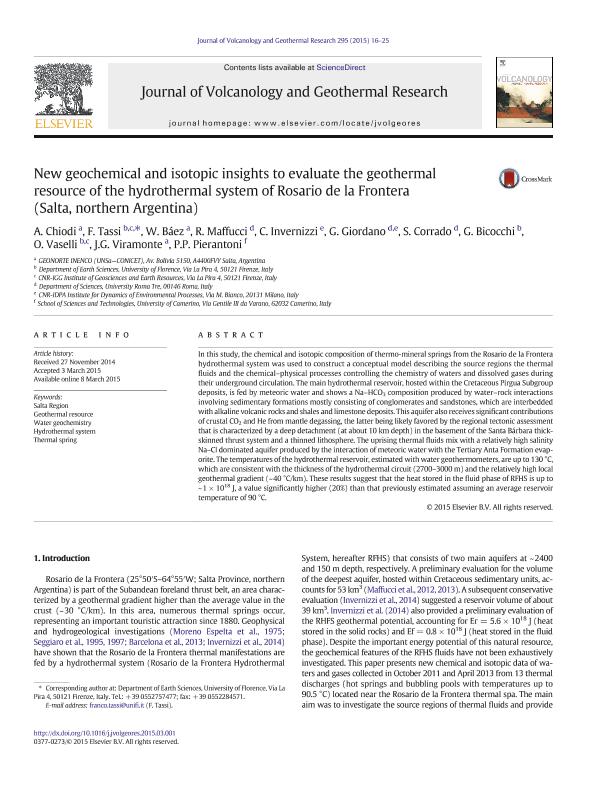Artículo
New geochemical and isotopic insights to evaluate the geothermal resource of the hydrothermal system of Rosario de la Frontera (Salta, northern Argentina)
Chiodi, Agostina Laura ; Tassi, F.; Baez, Walter Ariel
; Tassi, F.; Baez, Walter Ariel ; Maffucci, R.; Invernizzi, C.; Giordano, G.; Corrado, S.; Bicocchi, G.; Vaselli, O.; Viramonte, Jose German
; Maffucci, R.; Invernizzi, C.; Giordano, G.; Corrado, S.; Bicocchi, G.; Vaselli, O.; Viramonte, Jose German ; Pierantoni, P.P.
; Pierantoni, P.P.
 ; Tassi, F.; Baez, Walter Ariel
; Tassi, F.; Baez, Walter Ariel ; Maffucci, R.; Invernizzi, C.; Giordano, G.; Corrado, S.; Bicocchi, G.; Vaselli, O.; Viramonte, Jose German
; Maffucci, R.; Invernizzi, C.; Giordano, G.; Corrado, S.; Bicocchi, G.; Vaselli, O.; Viramonte, Jose German ; Pierantoni, P.P.
; Pierantoni, P.P.
Fecha de publicación:
03/2015
Editorial:
Elsevier Science
Revista:
Journal of Volcanology and Geothermal Research
ISSN:
0377-0273
Idioma:
Inglés
Tipo de recurso:
Artículo publicado
Clasificación temática:
Resumen
In this study, the chemical and isotopic composition of thermo-mineral springs from the Rosario de la Frontera hydrothermal system was used to construct a conceptual model describing the source regions the thermal fluids and the chemical-physical processes controlling the chemistry of waters and dissolved gases during their underground circulation. The main hydrothermal reservoir, hosted within the Cretaceous Pirgua Subgroup deposits, is fed by meteoric water and shows a Na-HCO3 composition produced by water-rock interactions involving sedimentary formations mostly consisting of conglomerates and sandstones, which are interbedded with alkaline volcanic rocks and shales and limestone deposits. This aquifer also receives significant contributions of crustal CO2 and He from mantle degassing, the latter being likely favored by the regional tectonic assessment that is characterized by a deep detachment (at about 10km depth) in the basement of the Santa Bárbara thick-skinned thrust system and a thinned lithosphere. The uprising thermal fluids mix with a relatively high salinity Na-Cl dominated aquifer produced by the interaction of meteoric water with the Tertiary Anta Formation evaporite. The temperatures of the hydrothermal reservoir, estimated with water geothermometers, are up to 130°C, which are consistent with the thickness of the hydrothermal circuit (2700-3000m) and the relatively high local geothermal gradient (~40°C/km). These results suggest that the heat stored in the fluid phase of RFHS is up to ~1×1018J, a value significantly higher (20%) than that previously estimated assuming an average reservoir temperature of 90°C.
Archivos asociados
Licencia
Identificadores
Colecciones
Articulos(INENCO)
Articulos de INST.DE INVEST.EN ENERGIA NO CONVENCIONAL
Articulos de INST.DE INVEST.EN ENERGIA NO CONVENCIONAL
Citación
Chiodi, Agostina Laura; Tassi, F.; Baez, Walter Ariel; Maffucci, R.; Invernizzi, C.; et al.; New geochemical and isotopic insights to evaluate the geothermal resource of the hydrothermal system of Rosario de la Frontera (Salta, northern Argentina); Elsevier Science; Journal of Volcanology and Geothermal Research; 295; 3-2015; 16-25
Compartir
Altmétricas



